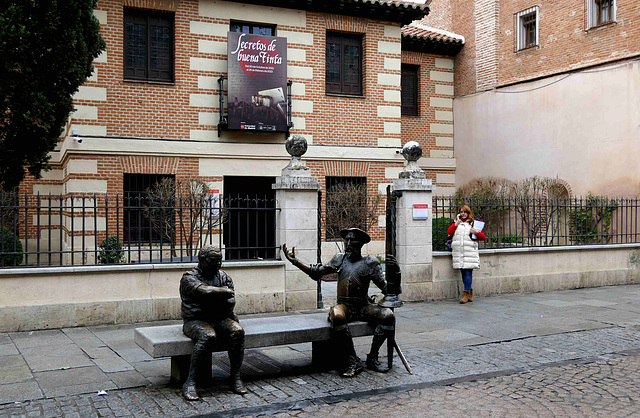Location
Lat, Lng:
Lat, Lng:
You can copy the above to your favourite mapping app.
Address: unknown
Lat, Lng:
You can copy the above to your favourite mapping app.
Address: unknown
See also...
Keywords
Authorizations, license
-
Visible by: Everyone -
All rights reserved
-
37 visits
Alcalá de Henares - Museo de casa natal de Cervantes


Alcalá de Henares is a city in the "Community of Madrid", located about 30 kilometers northeast of the center of Madrid. It has a population of about 200,000.
In the first century AD, the Romans founded a settlement in the Henares Valley, which they called Complutum. The city thrived because it was an important waypoint on the road between Mérida and Zaragoza and had a population of over 10,000. In 711, during the conquest by the Moorish Berber people, the Christian city was not taken. On the other side of the Henares River, a Muslim-built fortress was built, which existed for over 400 years in a relatively peaceful neighborhood with the Christian-inhabited settlement. In 1118, the Archbishop of Toledo Bernardo de Sedirac conquered the Muslim settlement. Alcalá received city rights in 1184.
In 1499, Francisco Jiménez de Cisneros, Archbishop of Toledo, whose archdiocese then included the city, founded a university here. Together with the Colegio Mayor building, Cisneros had six Colegios Menores built from 1499. The colegios were the part of the university where the students who attended lectures from the various departments lived and learned.
-
Don Quixote sits on a bench in front of the house where Miguel de Cervantes was born in 1475.
In 1569 Cervantes moved to Rome, where he worked for a cardinal. In 1570 he joined the Spanish Navy and was seriously wounded in the Battle of Lepanto in October 1571. As a result, his left arm and hand were permanently paralyzed. He served as a soldier until he was captured by Barbary pirates in 1575. After unsuccessful attempts to escape, Cervantes was ransomed by the Trinitarian Order in 1580 and returned to Spain.
In 1585 he worked as a tax collector but he also seized church property, he was excommunicated by an inquisition court. In May 1590 he applied in writing for the vacant governorship of the Central American province of Soconusco, but his request was rejected. 1597/98 he spent 3 months in custody in Seville prison for alleged embezzlement of state funds.
There he began work on his most important work, "El ingenioso Hidalgo Don Quijote de la Mancha". The first part of which appeared in 1605. He published the second part in 1615. Although Don Quixote brought the desired success, Cervantes lost the money he had gained. In the spring of 1616, his health deteriorated noticeably. He made his final vows to the Franciscan community. He died impoverished on April 22, 1616, in Madrid.
In the first century AD, the Romans founded a settlement in the Henares Valley, which they called Complutum. The city thrived because it was an important waypoint on the road between Mérida and Zaragoza and had a population of over 10,000. In 711, during the conquest by the Moorish Berber people, the Christian city was not taken. On the other side of the Henares River, a Muslim-built fortress was built, which existed for over 400 years in a relatively peaceful neighborhood with the Christian-inhabited settlement. In 1118, the Archbishop of Toledo Bernardo de Sedirac conquered the Muslim settlement. Alcalá received city rights in 1184.
In 1499, Francisco Jiménez de Cisneros, Archbishop of Toledo, whose archdiocese then included the city, founded a university here. Together with the Colegio Mayor building, Cisneros had six Colegios Menores built from 1499. The colegios were the part of the university where the students who attended lectures from the various departments lived and learned.
-
Don Quixote sits on a bench in front of the house where Miguel de Cervantes was born in 1475.
In 1569 Cervantes moved to Rome, where he worked for a cardinal. In 1570 he joined the Spanish Navy and was seriously wounded in the Battle of Lepanto in October 1571. As a result, his left arm and hand were permanently paralyzed. He served as a soldier until he was captured by Barbary pirates in 1575. After unsuccessful attempts to escape, Cervantes was ransomed by the Trinitarian Order in 1580 and returned to Spain.
In 1585 he worked as a tax collector but he also seized church property, he was excommunicated by an inquisition court. In May 1590 he applied in writing for the vacant governorship of the Central American province of Soconusco, but his request was rejected. 1597/98 he spent 3 months in custody in Seville prison for alleged embezzlement of state funds.
There he began work on his most important work, "El ingenioso Hidalgo Don Quijote de la Mancha". The first part of which appeared in 1605. He published the second part in 1615. Although Don Quixote brought the desired success, Cervantes lost the money he had gained. In the spring of 1616, his health deteriorated noticeably. He made his final vows to the Franciscan community. He died impoverished on April 22, 1616, in Madrid.
kiiti has particularly liked this photo
- Keyboard shortcuts:
Jump to top
RSS feed- Latest comments - Subscribe to the comment feeds of this photo
- ipernity © 2007-2024
- Help & Contact
|
Club news
|
About ipernity
|
History |
ipernity Club & Prices |
Guide of good conduct
Donate | Group guidelines | Privacy policy | Terms of use | Statutes | In memoria -
Facebook
Twitter

Sign-in to write a comment.